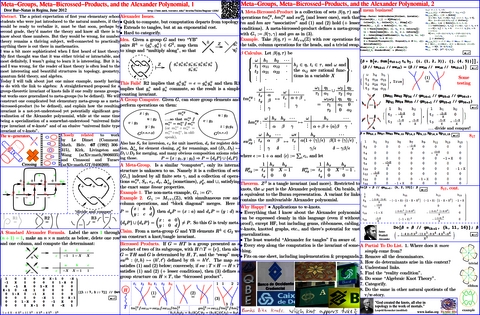
Handout: beta.html, beta.pdf, beta.png.
Sources: beta.zip. Pensieve / Program: 2012-06 / Regina_Talk.

Handout: beta.html, beta.pdf, beta.png.
Sources: beta.zip. Pensieve / Program: 2012-06 / Regina_Talk.
Abstract. The a priori expectation of first year elementary school students who were just introduced to the natural numbers, if they would be ready to verbalize it, must be that soon, perhaps by second grade, they'd master the theory and know all there is to know about those numbers. But they would be wrong, for number theory remains a thriving subject, well-connected to practically anything there is out there in mathematics.
I was a bit more sophisticated when I first heard of knot theory. My first thought was that it was either trivial or intractable, and most definitely, I wasn't going to learn it is interesting. But it is, and I was wrong, for the reader of knot theory is often lead to the most interesting and beautiful structures in topology, geometry, quantum field theory, and algebra.
Today I will talk about just one minor example, mostly having to do with the link to algebra: A straightforward proposal for a group-theoretic invariant of knots fails if one really means groups, but works once generalized to meta-groups (to be defined). We will construct one complicated but elementary meta-group as a meta-bicrossed-product (to be defined), and explain how the resulting invariant is a not-yet-understood yet potentially significant generalization of the Alexander polynomial, while at the same time being a specialization of a somewhat-understood "universal finite type invariant of w-knots" and of an elusive "universal finite type invariant of v-knots".

Handout: bh.html, bh.pdf, bh.png. Sources: bh.zip. Pensieve: 2012-08.
There's also a paper in progress.
Talk cancelled due to illness.
This will be a repeat of a talk I gave in Hamburg in August 2012.Abstract. Balloons are two-dimensional spheres. Hoops are one dimensional loops. Knotted Balloons and Hoops (KBH) in 4-space behave much like the first and second fundamental groups of a topological space - hoops can be composed like in π1, balloons like in π2, and hoops "act" on balloons as π1 acts on π2. We will observe that ordinary knots and tangles in 3-space map into KBH in 4-space and become amalgams of both balloons and hoops.
We give an ansatz for a tree and wheel (that is, free-Lie and cyclic word) -valued invariant ζ of KBHs in terms of the said compositions and action and we explain its relationship with finite type invariants. We speculate that ζ is a complete evaluation of the BF topological quantum field theory in 4D, though we are not sure what that means. We show that a certain "reduction and repackaging" of ζ is an "ultimate Alexander invariant" that contains the Alexander polynomial (multivariable, if you wish), has extremely good composition properties, is evaluated in a topologically meaningful way, and is least-wasteful in a computational sense. If you believe in categorification, that's a wonderful playground.
Talk cancelled due to illness.
This will be a repeat of a talk I gave in Regina in June 2012 and of talk 1 above.